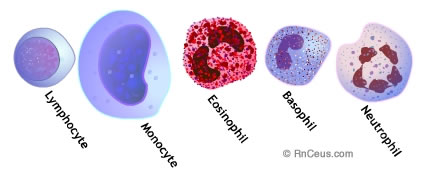

White blood cells, or leukocytes, are classified into two main groups: granulocytes and nongranulocytes (also known as agranulocytes).
The lifespan of white blood cells ranges from 13 to 20 days, after which time they are destroyed in the lymphatic system. When immature WBCs are first released from the bone marrow into the peripheral blood, they are called "bands" or "stabs." Leukocytes fight infection through a process known as phagocytosis. During phagocytosis, the leukocytes surround and destroy foreign organisms. White blood cells also produce, transport, and distribute antibodies as part of the body's immune response.
Two measurements of white blood cells are commonly done in a CBC:
Normal values for total WBC and differential in adult males and females are:
Each differential always adds up to 100%. To make an accurate assessment, consider both relative and absolute values. For example a relative value of 70% neutrophils may seem within normal limits; however, if the total WBC is 20,000, the absolute value (70% x 20,000) would be an abnormally high count of 14,000.
Instant Feedback:
The numbers of leukocytes changes with age and during pregnancy.
Leukocytosis, a WBC above 10,000, is usually due to an increase in one of the five types of white blood cells and is given the name of the cell that shows the primary increase.
In response to an acute infection, trauma, or inflammation, white blood cells release a substance called colony-stimulating factor (CSF). CSF stimulates the bone marrow to increase white blood cell production. In a person with normally functioning bone marrow, the numbers of white blood cells can double within hours if needed. An increase in the number of circulating leukocytes is rarely due to an increase in all five types of leukocytes. When this occurs, it is most often due to dehydration and hemoconcentration. In some diseases, such as measles, pertussis and sepsis, the increase in white blood cells is so dramatic that the picture resembles leukemia. Leukemoid reaction, leukocytosis of a temporary nature, must be differentiated from leukemia, where the leukocytosis is both permanent and progressive.
Therapy with steroids modifies the leukocytosis response. When corticosteroids are given to healthy persons, the WBC count rises. However, when corticosteroids are given to a person with a severe infection, the infection can spread significantly without producing an expected WBC rise. An important concept to remember is that, leukocytosis as a sign of infection can be masked in a patient taking corticosteroids.
Instant Feedback:
Leukopenia occurs when the WBC falls below 4,000. Viral infections, overwhelming bacterial infections, and bone marrow disorders can all cause leukopenia. Patients with severe leukopenia should be protected from anything that interrupts skin integrity, placing them at risk for an infection that they do not have enough white blood cells to fight. For example, leukopenic patients should not have intramuscular injections, rectal temperatures or enemas.
Drugs that may produce leukopenia include:
Leukocytes: critical low and high values
When a patient is receiving chemotherapy that suppresses bone marrow production of leukocytes, the point at which the count is lowest is referred to as the nadir.
© RnCeus.com